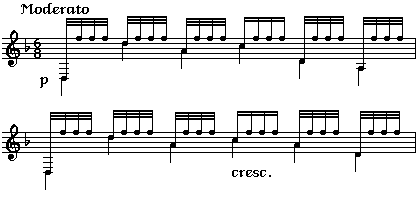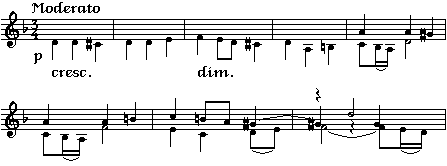Variations
sur >>Folia de España<< et
Fugue. Edited by Andrés Segovia. Mainz:
Schott, 1932.
Timing:
24'
Grade:
10
In 1928 Segovia
asked Ponce to write a large set of variations: "I
would like you to make some brilliant variations on
the theme of the Folias of Spain. . . If you
don't want to sign it we can ascribe it to
Giuliani, of whom many things remain to be
discovered."4 Although this letter
implies that Segovia may have expected a pastiche
in the early nineteenth-century style of Giuliani,
Ponce, in 1929, created a powerful contemporary
work comparable in technical demands to Bach's
famous Chaconne from the Partita No. II for solo
violin.
The folias
originated in the Iberian peninsula, probably
Portugal, during the late fifteenth-century. Like
its relatives the chaconne and passacaglia, the
folias is in triple meter and is based on a
repeating harmonic pattern. The folias pattern
consists of two eight-measure periods. Although
sixteenth-century and seventeenth-century examples
of the folias utilized alternations of 3/4 and 6/8
meter, Ponce's setting of the theme, like those of
the nineteenth-century such as Giuliani's opus 45,
remains in 3/4 meter throughout.
This work consists
of a theme, twenty variations and a fugue—twenty
pages of single-stave notation. Because this work
is in D minor, a scordatura tuning of D-A-d-g-b-e1
is utilized to maximize the use of open basses.
According to correspondence between Segovia and
Ponce, this work originally included a
prélude: "Whenever I write I am tempted to
explain why I haven't offered the Prélude,
Folias and Fugue to Schott"; and, in another letter
concerning a performance at the Paris Opera during
1931, "I am thinking of including the Variations on
the Folias, without the Prélude, but with
the Fugue."5
Duarte, writing on
this set of variations, comments that "Segovia
deemed a few of the many variations Ponce produced
as unsuitable, either to the guitar or to the work
as an entity."6 In fact, one of these
unpublished variations was recorded by Segovia
under the title of Postlude on
Andrés Segovia: The EMI Recordings
1927-39 (Angel ZB-3896). Thus, considering the
cutting of the prélude, the new setting of
the theme and the various unpublished variations,
Segovia exercised considerable influence on the
final form of this work.
The setting of the
theme has gone through at least one major revision
before arriving at its published form. After
recording this work in the late 1920s, Segovia
asked Ponce to rewrite the setting of the
theme.7 Thus, the published score
utilizes chromatic and nontraditional harmonies in
the theme not heard on Segovia's early recording of
this work. The following excerpt is taken from the
published score (Schott, 1932):
Ex. 62.
Variations sur >>Folia de
España<< et Fugue, Theme, p. 3, mm.
1-4

Although space does
not permit discussion of all twenty variations, key
characteristics of the work will be considered. The
general style of this work is an amalgam of
neoclassic treatment of form, neoromantic lyricism
and expression, and a mixture of neoromantic and
impressionistic harmonies. Each of the variations
derive from various combinations of the melodic,
rhythmic or harmonic traits of the theme. There is
marked contrast between variations in terms of
tempo, meter, texture and melodic figuration; thus,
each variation has a distinct character of its own.
This work departs from the D minor mode only three
times: in Variation VI, in A major; Variation IX,
in D major; and Variation XI, in C
major.
Variation II, in
6/4 meter and marked Allegretto mosso, is based on
scale and arpeggio figuration in running eighth
notes. Common practice harmony predominates in this
variation.
Ex. 63.
Variations sur >>Folia de
España<< et Fugue, Variation II, p. 4,
mm. 1-2

Variation VII, in
3/4 and marked Andante, utilizes nontraditional
harmonies in block chord fashion and is reminiscent
of the Baroque with its opening mordent and use of
a neighboring tone group in the V7 i cadence at m.
4:
Ex. 64.
Variations sur >>Folia de
España<< et Fugue, Variation VII, p.
8, mm. 1-4

Variation XIII, a
canon at the octave, recalls the Baroque in its use
of contrapuntal technique:
Ex. 65.
Variations sur >>Folia de
España<< et Fugue, Variation XIII, p.
13, mm. 1-3

Variation XVI, in
6/8 meter and marked moderato, features the tremolo
technique within a common practice harmonic
setting:
Ex. 66.
Variations sur >>Folia de
España<< et Fugue, Variation XVI, p.
15, mm. 1-2

The fugue, marked
moderato and in three voices, is based on a
four-measure subject derived from the
theme:
Ex. 67.
Variations sur >>Folia de
España<< et Fugue, Fugue, p. 20, mm.
1-8

Organized according
to eighteenth-century conventions, the exposition
consists of an initial presentation of the subject,
a real answer at the fifth (with countersubject), a
bridge and a restatement of the subject at the
octave. Likewise, the rest of the movement conforms
to Baroque fugal convention: a series of
developmental and modulatory episodes follow the
exposition and a three-voice stretto and an
extended dominant pedal passage appear near the
end. The dominant pedal passage is particularly
exciting (mm. 81-90): a motive from the
countersubject, over an open A pedal, ascends with
mounting tension to a high B2-flat and, in like
manner, descends to a final statement of the
subject harmonized in fortissimo block chords and a
coda based on the second counterpoint.
Ex. 68.
Variations sur >>Folia de
España<< et Fugue, Fugue, p. 22, mm.
81-85

As a self-contained
entity the fugue is a pleasant and well-conceived
work, although somewhat academic. However, as an
ending for a lengthy set of virtuosic variations
the fugue is anticlimactic and somewhat exhausting
for both listener and performer.
Despite Ponce's
skillful composition of individual variations, this
work as a whole lacks both spontaneity and
structural unity. Although the use of the sectional
variation form is successful in Ponce's shorter
variation sets, the manner in which it is used in
this work strikes the listener as a lengthy
succession of attractive pieces—i.e., each
variation is a balanced musical entity in
itself—rather than a continuous and dramatically
controlled whole.8 While Ponce's
character pieces show an excellent control of
dramatic tension and formal organization, longer
works such as Suite Antigua and the
Variations sur >>Folia de
España<< et Fugue show that Ponce
sometimes had difficulty maintaining dramatic
balance in extended sectional
compositions.
Footnotes
4Corazón
Otero, Manuel M. Ponce and the Guitar
(London: Musical New Services, 1983), p.
33.
5Ibid.,
pp. 39 and 41.
6Jacket
notes from the record Andrés Segovia: The
EMI Recordings 1927-39, (Angel
ZB-3896).
7Ibid.
8It is
possible that the unedited version of this
work—i.e., prélude, twenty-plus variations
in original placement and fugue—may have had a
significantly different musical impact than the
published version.
Source Materials
Otero,
Corazón. Manuel M. Ponce and the
Guitar. Translated by J. D. Roberts. Dorset,
England: Musical New Services, 1980. 85
pages.
Ponce, Manuel M.
Thème varié et Finale. Edited
by Andrés Segovia. Mainz: Schott, 1926. 7
pages.
Ponce, Manuel M.
Variations on a Theme of Cabezón. Edited by Miguel Alcázar. London: Tecla
Editions, 1983. 7 pages.
Ponce, Manuel M.
Variations sur >>Folia de
España<< et Fugue. Edited by
Andrés Segovia. Mainz: Schott, 1932. 22
pages.
Segovia,
Andrés: The EMI Recordings 1927-39.
Angel ZB-3896.
Reedsport, OR | Elk viewing park sans elk